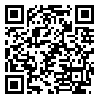1. Ahmadi, K., Nejati, V., & Abdi M., 2009. [Comparison of general health in adolescent boys and girls and its relationship with personality characteristics (Persian)]. Journal of Guilan University of Medical Sciences, 21(81), pp. 29-36.
2. Bakhshayesh, A. R., 2013. [The relationship between personality types and general health with job satisfaction of Yazd health center staffs (Persian)]. Journal of Payavard Salamat, 7(1), pp. 42-55.
3. Barry, R. A., Lakey, B., & Orehek, E., 2007. Links among attachment dimensions, affect, the self, and perceived support for broadly generalized attachment styles and specific bonds. Personality and Social Psychology Bulletin, 33(3), pp. 340-53. doi: 10.1177/0146167206296102 [
DOI:10.1177/0146167206296102]
4. Block, R. C. et al., 2013. International service and public health learning objectives for medical students. Health Education Journal, 72(5), pp. 530–6. doi: 10.1177/0017896912450874. [
DOI:10.1177/0017896912450874]
5. Chamorro-Premuzic, T. & Furnham, A., 2009. Mainly openness: The relationship between the big five personality traits and learning approaches. Learning and Individual Differences, 19(4), pp. 524–9. doi: 10.1016/j.lindif.2009.06.004 [
DOI:10.1016/j.lindif.2009.06.004]
6. De Haro, J. M., Castejón, J. L., & Gilar, R., 2013. General mental ability as moderator of personality traits as predictors of early career success. Journal of Vocational Behavior, 83(2), pp. 171-80. doi: 10.1016/j.jvb.2013.04.001 [
DOI:10.1016/j.jvb.2013.04.001]
7. Fortunato, V. J. & Furey, J. T., 2009. The theory of mind time and the relationships between thinking perspective and the big five personality traits. Personality and Individual Differences, 47(4), pp. 241–6. doi: 10.1016/j.paid.2009.03.006 [
DOI:10.1016/j.paid.2009.03.006]
8. Ghorbani, A., et al., 2013. [Correlation between type of personality and academic achievement of nursing students in university of medical sciences Qazvin (Persian)]. Iranian Journal of Nursing Research, 8(28), pp. 68-75.
9. Golestanbagh, N., et al., 2016. [Investigation of correlation between personality traits and dietary habits in female students (Persian)]. Qom University of Medical Sciemces, 10(3), pp. 55-63.
10. Hasanpour, M., Haghdoost-Oskouie, S. F., Salsalei, M., 2005. [Critical thinking in nursing education (Persian)]. Iran Journal of Nursing, 18(41-42), pp. 7-16.
11. Heravi-Karimooi, M., Rejeh, N., & Sharif Nia, H., 2014. [The relationship between nursing students' spiritual intelligence and their general health in Tehran, 2012 (Persian)]. Iranian Journal of Medical Education, 14(1), pp. 1-14.
12. Horney, J. A., et al., 2014. Fuelling the public health workforce pipeline through student surge capacity response teams. Journal of community health, 39(1), pp. 35-9. doi: 10.1007/s10900-013-9750-5 [
DOI:10.1007/s10900-013-9750-5]
13. Imani, E., et al., 2013. [Health status of nursing students of Hormozgan university of medical sciences by Goldberg's general health questionnaire-2011 (Persian)]. Bimonthly Journal of Hormozgan University of Medical Sciences, 17(4), pp. 357-64.
14. Khanjani, Z., & Bahadori-Khosroshahi, J., 2014. [The prediction of general health on the basis of body image, life stress and personality characteristics (Persian)]. Knowledge and Research in Applied Psychology, 15(58), pp. 40-7.
15. Khansanami, S. H., et al., 2015. [The relationship between religious orientation and students' quality of life at medical sciences university of Qom (Persian)]. Journal of Sabzevar University of Medical Sciences, 22(2), pp. 282-8.
16. Komarraju, M., Karau, S. J., & Schmeck, R. R., 2009. Role of the big five personality traits in predicting college students' academic motivation and achievement. Learning and Individual Differences, 19(1), pp. 47-52. doi: 10.1016/j.lindif.2008.07.001 [
DOI:10.1016/j.lindif.2008.07.001]
17. Kouchakzadeh-Talami, S., Alizadeh, Sh., & Namazi, A., 2015. [Assessment the relationship between emotional intelligence and general health among nursing students (Persian)]. Jundishapur Scientific Medical Journal, 6(2), pp. 139-46.
18. Lamers, S. M. A. et al., 2012. Differential relationships in the association of the Big Five personality traits with positive mental health and psychopathology. Journal of Research in Personality, 46(5), pp.517–24. doi: 10.1016/j.jrp.2012.05.012. [
DOI:10.1016/j.jrp.2012.05.012]
19. Maleki, Z., et al., 2013. [Relationship between personality traits, religiousity and happiness with general health among nursing students (Persian)]. Iran Journal of Nursing, 26(86), pp. 90-100.
20. McGready, J., & Brookmeyer, R., 2013. Evaluation of student outcomes in online vs. campus biostatistics education in a graduate school of public health. Preventive Medicine, 56(2), pp. 142–4. doi: 10.1016/j.ypmed.2012.11.020. [
DOI:10.1016/j.ypmed.2012.11.020]
21. Moallemi, S., Bakhshani, N. M., & Raghibi, M., 2011. [On the relationship between mental health, spiritual intelligence and dysfunctional attitudes in students of Systan and Baluchestan University, Southeast of Iran (Persian)]. Quart Journal Fundamental Mental Health, 3(48), pp. 702-9.
22. Namazi, A., & Alizadeh, S., 2015. [General health in nursing and midwifery students and its relationship with academic achievement (Persian)]. Journal of Nursing Education, 4(3), pp. 11-8.
23. Noorbala, A. A., Bagheri Yazdi, S. A., Mohamad, K., 2009. [The validiation of general health Questionaire-28asa psychiatric screening Tool (Persian)]. Hakim, 11(4), pp. 47-53.
24. Rahaei, Z., et al., 2015. [The relationship between demographic variables with general health and quality of life in students of Islamic Azad University, Sabzevar Branch, Iran (Persian)]. Qom University of Medical Sciences Journal, 9(10), pp. 40-7.
25. Sotodeh, N., et al., 2014. [Comparison of health status among junior and senior students of nursing and medicine in Semnan university of medical sciences in 2011-2012 academic years (Persian)]. Iranian Journal of Medical Education, 14(3), pp. 232-40.
26. Zare', H., & Mohammadzadeh, R., 2012. [The role of personality traits in predicting students' achievement motivation (Persian)]. Journal of Education & Psychology. 4(1), pp. 117-138.






